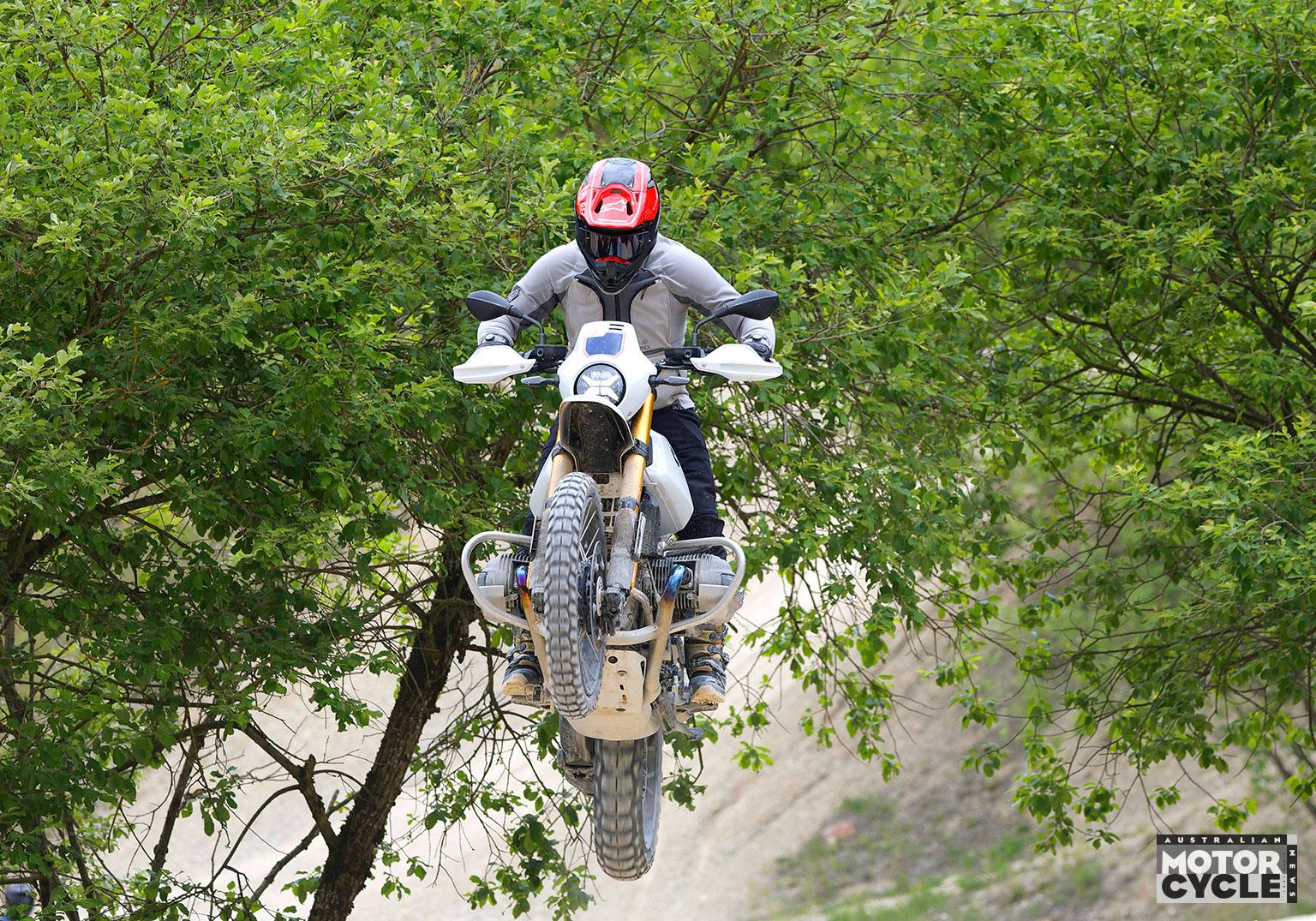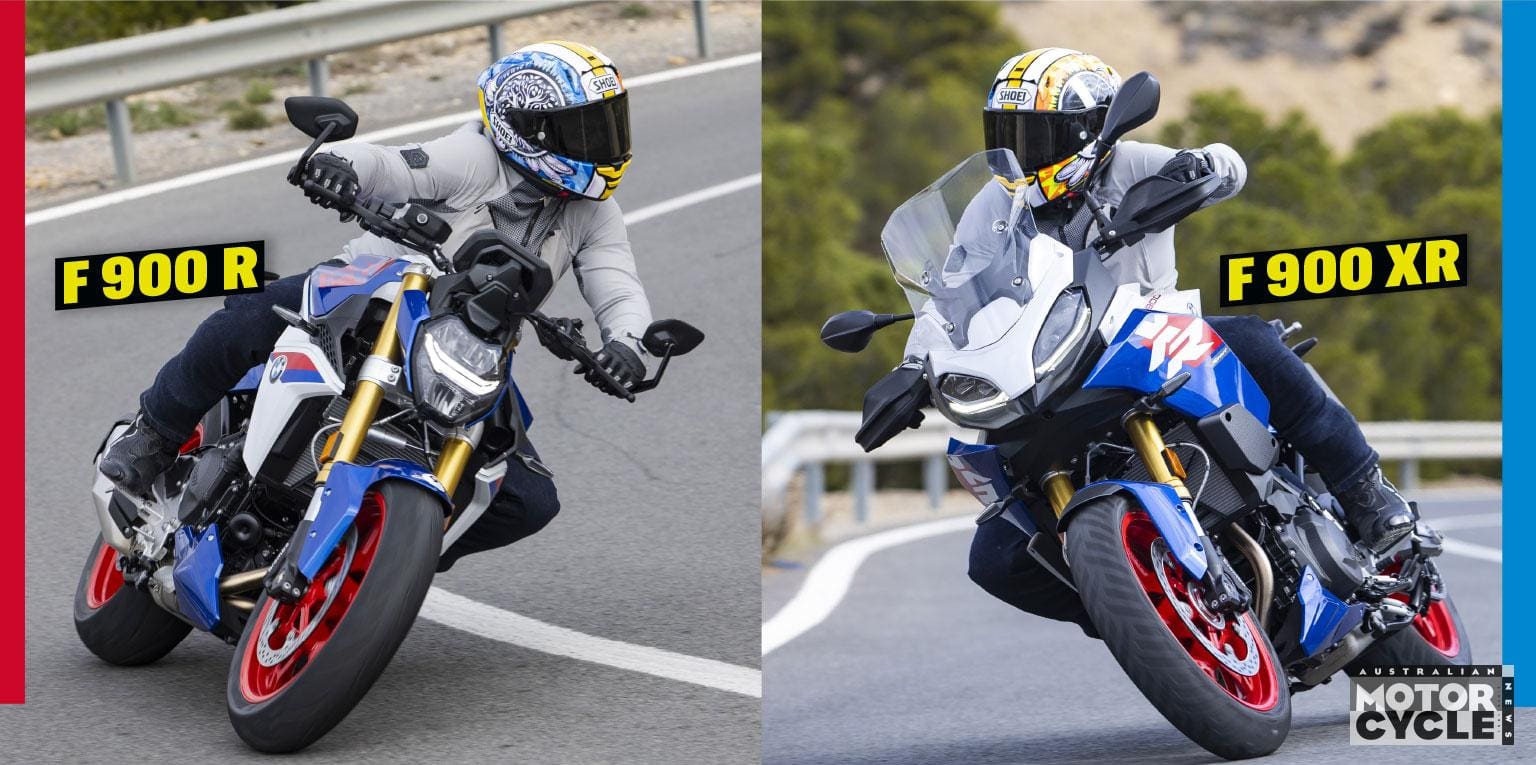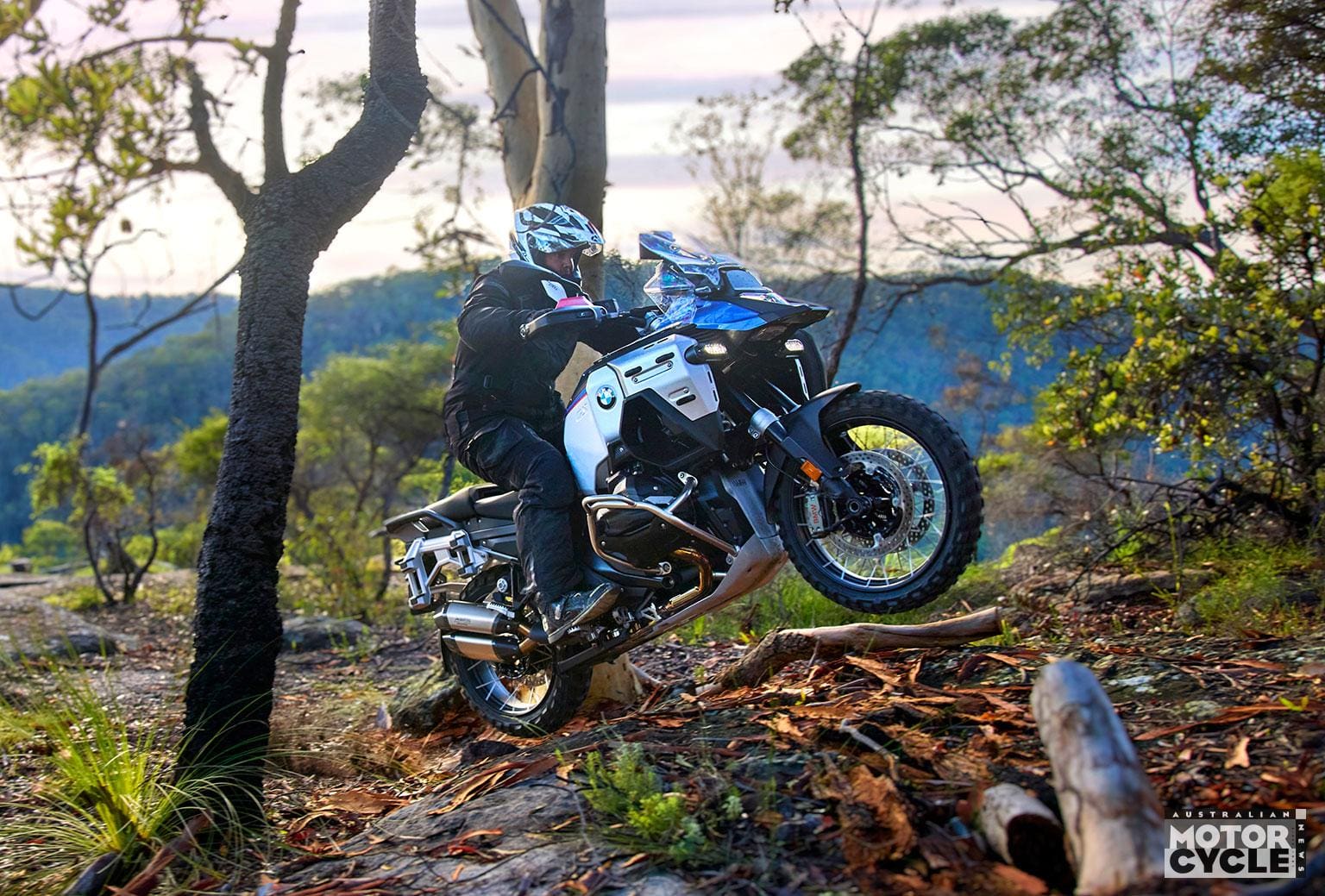If you’re anything like me you might associate the Benelli badge with iconic machines like the Tornado 900 or the mighty TNT 1130, but times have changed, with the adventure segment now exploding in popularity. Dual-purpose machines are one of the fastest growing motorcycle categories, with new models seemingly appearing every other month. For Aussies with wanderlust and a motorcycle licence there’s simply no better way to go exploring, and Benelli’s new TRK 702X all-rounder promises to be able to get you so far off grid you can almost hear the banjos.
Benelli is the second oldest continuous motorcycle manufacturer in the world (see sidebar), but more recently it’s been increasing the breadth of its product range under the stewardship of Chinese owner Geely. The TRK 702X comes in above the TRK 251 and 502 as its largest-capacity adventure model, with increased capability and performance, but to take the chocolates in the savagely contested mid-weight turf war it’s going to have to come out swinging. It lands an uppercut on the competition straight away though, with a very punchy $13,590 ride-away price tag, undercutting Suzuki’s $16,990 V-Strom 800DE, Yamaha’s $20,349 Tenere 700, Honda’s $16,025 XL750 Transalp and even CFMoto’s $16,990 800MT Explore.
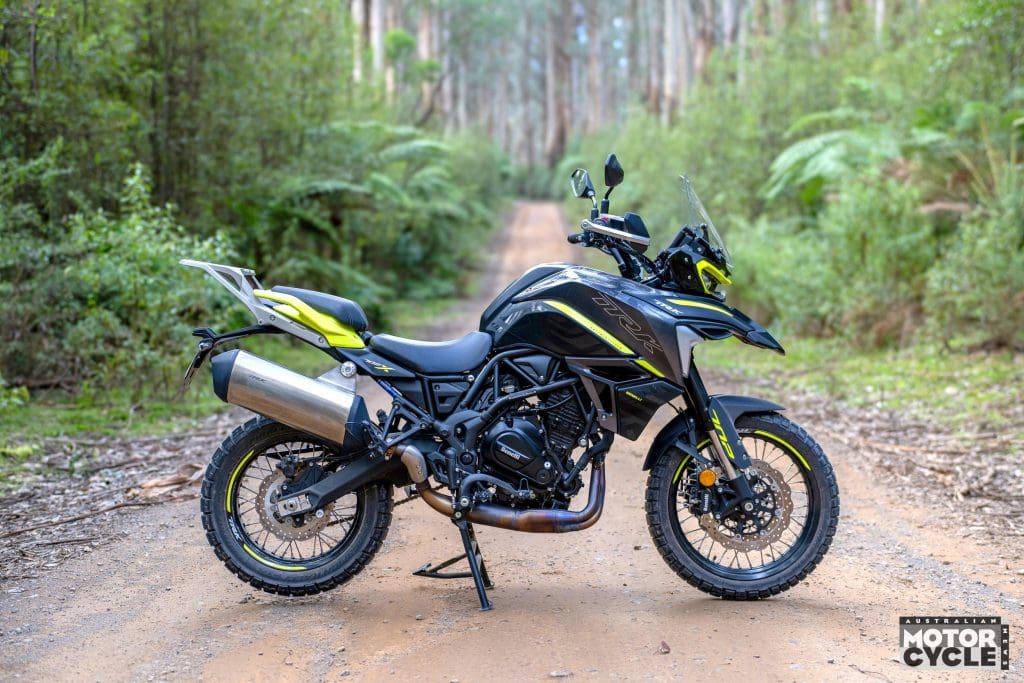
Parallel-twins are ‘the new black’ when it comes to mid-weight motorcycles of all shapes and sizes, especially so in the adventure segment. There’s a good reason for that though, as they offer a lovely, broad spread of torque and smooth power delivery without upsetting the Euro 5 emissions cart. The fact they are so inherently compact also means the engineers can optimise the engine position for ideal weight distribution, which is important for on and off-road dynamics.
The TRK 702X’s 698cc four-valve per cylinder, double-overhead-cam powerplant pushes out 51.5kW (69hp) at 8000rpm and 70Nm at 6000rpm, which is about par for this adventure segment. However, this is a case where numbers really don’t do justice to the TRK’s performance.
Every time I jumped on the Pesaro-developed machine I was floored by how exuberantly the twin shoved me down the road at just about all points in the rev range. The torquey response made overtaking a breeze on the freeway, even in top gear where it trotted along at about 4500rpm at 100km/h. I’ve sampled quite a few parallel twins recently, but Benelli has mixed some sort of special Italian sauce into this unit that makes it a hoot to belt around on whether you’re riding on tarmac or gravel.
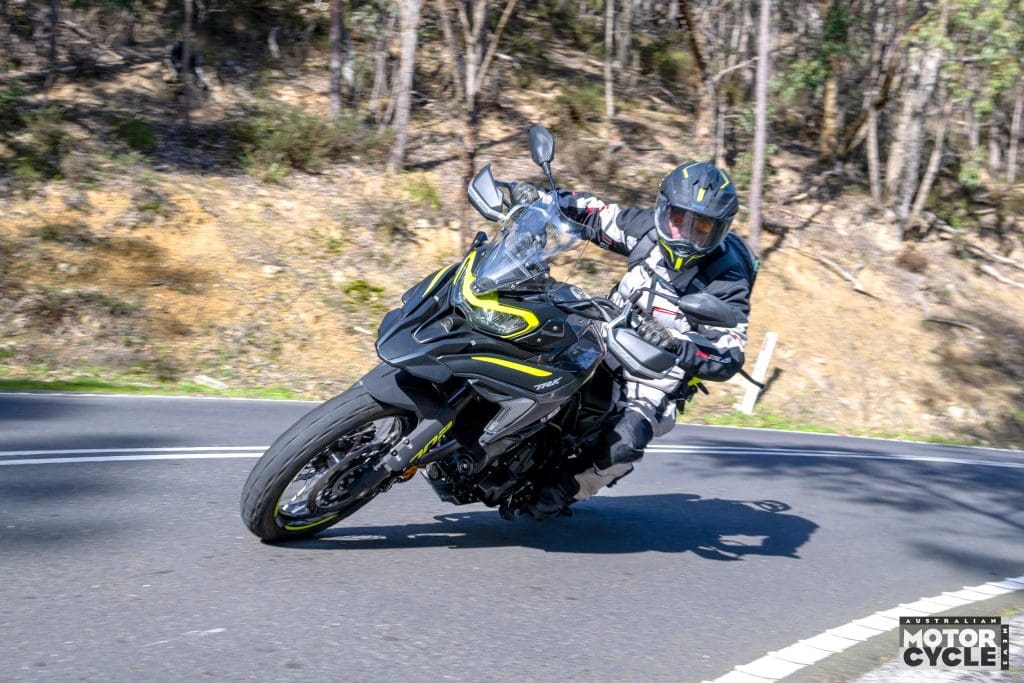
The throttle mapping at low rpm makes it feel like you can ration out each individual rev to the rear tyre when you’re searching for traction up a dirt trail, but there’s also real pleasure to be had in winding out the TRK. Even with the stock exhaust it’s got a fruity note, building to startlingly soulful symphony as you dial up the revs. It does run out of puff slightly at the top end of the tacho, but it sounds so good that it’s hard not to give it a good flogging every time you find yourself at a traffic light or freeway on-ramp.
The power delivery and tune feel perfectly judged for commuting and dirt-road shenanigans alike, which is just as well as there are no adjustable engine maps to be found when scrolling through the bright and clear five-inch TFT menu. Neither is there any form of traction control, which is a bit unusual on a modern adventure bike, but when you’re paying less than 14 grand there has to be compromises.
Front and rear ABS is included as standard though, along with a USB-A/USB-C charging ports and Bluetooth phone connectivity that allows you to answer calls while riding by using the simple switchblock buttons. You can also mirror your smartphone navigation to the screen by downloading the ‘Carbit Ride’ app and hotspotting your wifi. It’s a bit of a complex process but thankfully you only have to set it up once.
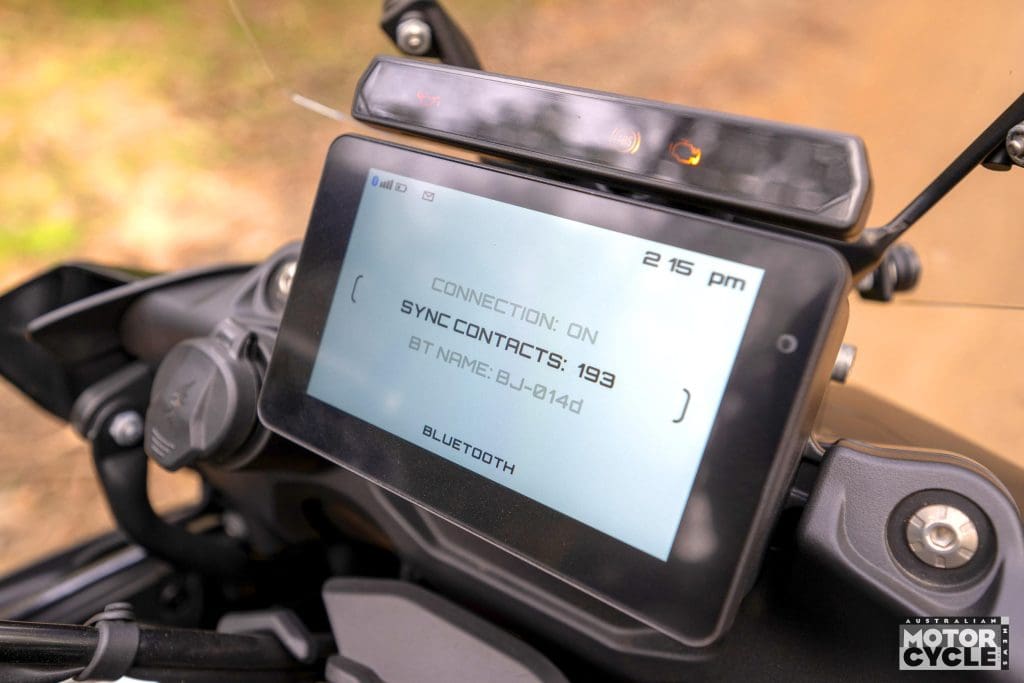
In terms of electronics, it’s a fairly short paragraph then, but that also means there’s less that can go wrong should you drop it. Some adventure bikes have become so complex that it makes you wonder whether a computer science expert would have to be choppered in to get you going again should some obscure sensor get shaken loose down a gully somewhere.
The 702X feels plenty sturdy enough to cope with a beating, with a beefy 50mm inverted fork, fully adjustable rear shock with remote preload adjuster for when you’re lugging a load, and dual-pot front brake calipers gripping 320mm wave-disc rotors.
It’s off-road chops are further enhanced by robust handguards, serrated-steel footpegs, a centrestand, engine skidplate, iron-spoked wheels and knobby Pirelli Scorpion Rally STR tyres. Considering the Italian styling and what appears to be top-notch build quality, the TRK feels a much more high-end product than the price tag suggests.
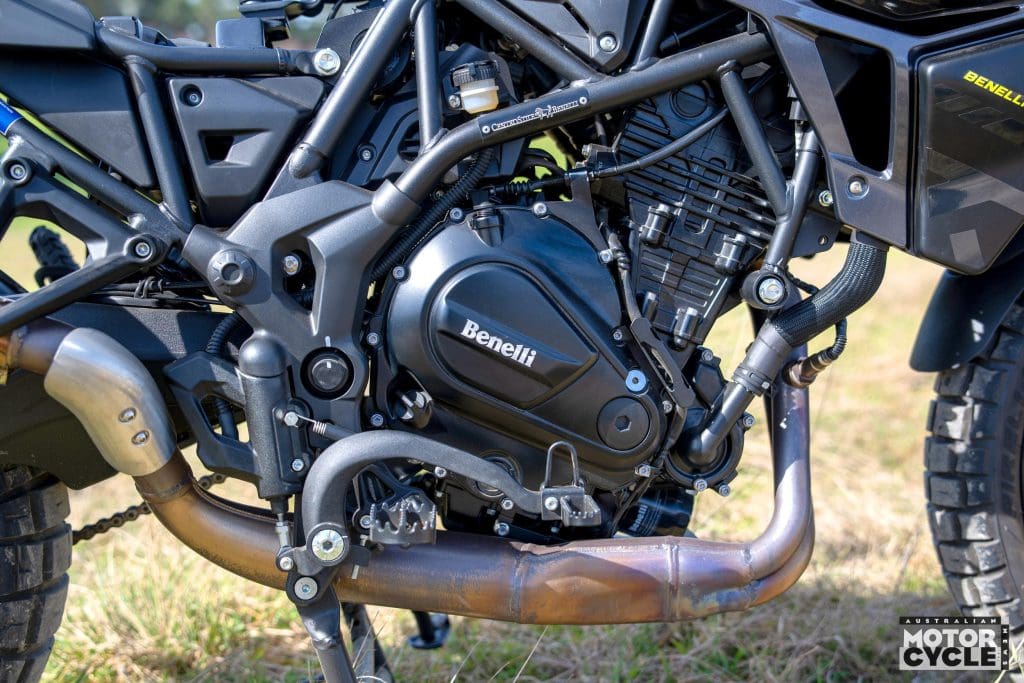
While the tyres are suited to off road pursuits, the front rim remains a more road-biased 19-inch diameter, but that does help it turn beautifully on blacktop. The TRK’s lofty 835mm seat and 235kg wet weight mean this is undoubtedly a full-size adventurer despite its ‘mid-weight’ designation, but once on the move it feels to shrink underneath as you settle onto the broad saddle and get rolling.
That mass centralisation makes the TRK as easy to chuck from side to side as a big wide-’bar chook-chaser. I found myself having a ball on twistier sections of road in the hills. It’s amazing that an adventure bike on knobby tyres should feel so competent on the road, and the bonus is that the TRK’s lengthy 140mm fork stroke and 173mm rear wheel travel allows you to soak up poorly maintained bitumen with smug confidence rather than gritted teeth. The fork feels nicely damped and, although the front lever likes a good squeeze to pull you up, the brakes provide plenty of stopping power when you throw out the anchors.
The TRK’s cruising manners are also impressive, with the mid-mounted ’pegs, neutrally placed ’bar and wide, supportive seat making the boring bits more than tolerable. The mirrors offer a nice clear view of the traffic behind, and the screen does a pretty decent job of deflecting the wind blast away from the head and shoulders, although taller riders might bemoan the lack of adjustment.
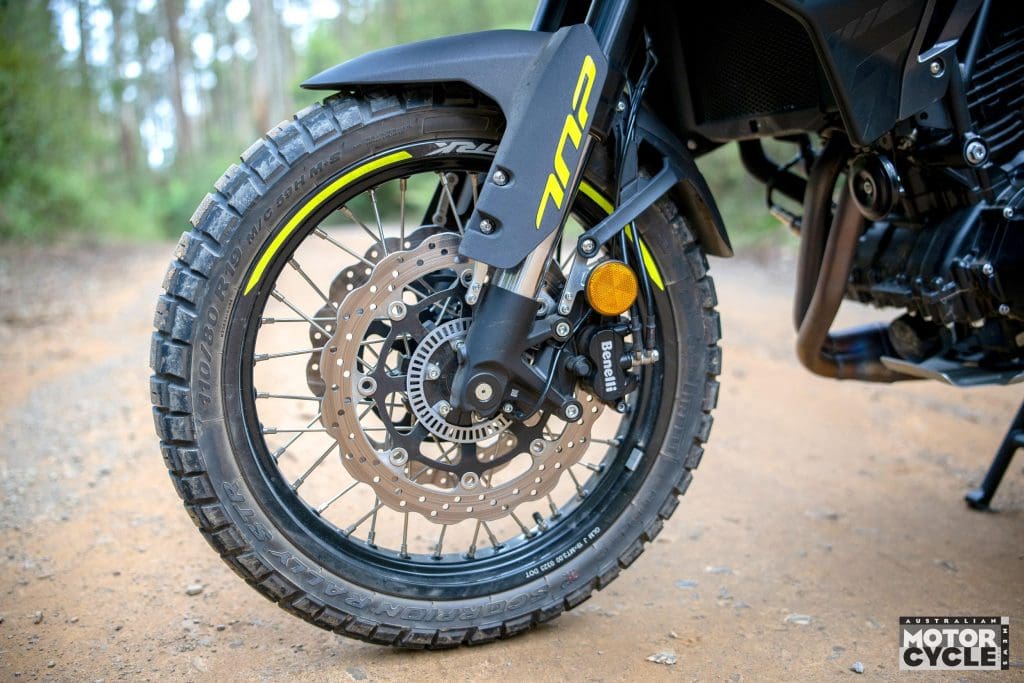
Passengers get looked after as well, with roomy rubber-mounted ’pegs, generous pillion seat and solid grabrails. The lofty rider’s perch provides a great view of the road ahead which, combined with the enthusiastic engine and excellent manoeuvrability, makes the TRK an excellent tool for vanquishing the urban mayhem.
A 20-litre fuel tank means you only need to splash and dash every 300km or so, and the light, butter-smooth gearbox makes toeing the lever precise and easy.
It’s really liberating to be able to just point the TRK down the nearest gravel track and see where the path takes you. I quickly found the same attributes that made the TRK dynamics so good on the blacktop meant I was able to settle into an easy rhythm on gravel. I’m not sure what form of alchemy Pirelli has brewed into its Scorpion tyres to imbue them with such good feel on vastly different surfaces, but sweeping through unsealed bends while standing on the TRK’s wide ’pegs felt as natural as being seated on tarred roads.
The TRK may not have traction control but I prefer to steer with the throttle a bit more on loose surfaces anyway, and the 698cc twin allowed to me to summon just the right amount of slip from the knobby tyres to maintain momentum while traversing snotty inclines. Let’s face it, half the fun of dirt riding is spinning the rear out every switchback like a kid with his first BMX.

The always-on ABS prevents similarly silly skids, but that seemed eminently prudent while massaging the front tyre down precipitous rocky sections overlooking mountainous cliffs with sweaty palms. Once again though, the brake feel is a perfect compromise for off-road endeavours. Where on tarmac, the calipers can feel a touch lacking in bite, on dirt and stones the lack of any grabbiness translated to excellent lever modulation and feedback.
It was only when we started tackling more challenging singletrack that the TRK’s size and weight started to impose themselves. When the going got rough enough that it became necessary to slow down and plant the foot on the ground occasionally for some extra support, it could require a fair bit of strength and quick stepping to keep the front of the TRK lurching in the right direction. It’s here that a larger 21-inch front rim would be beneficial for maintaining stability through deep ruts. When I had to get photographer Rob to help haul me out of one particularly cavernous trench, I decided it was probably time to abandon my Finke aspirations and journey back to civilisation.
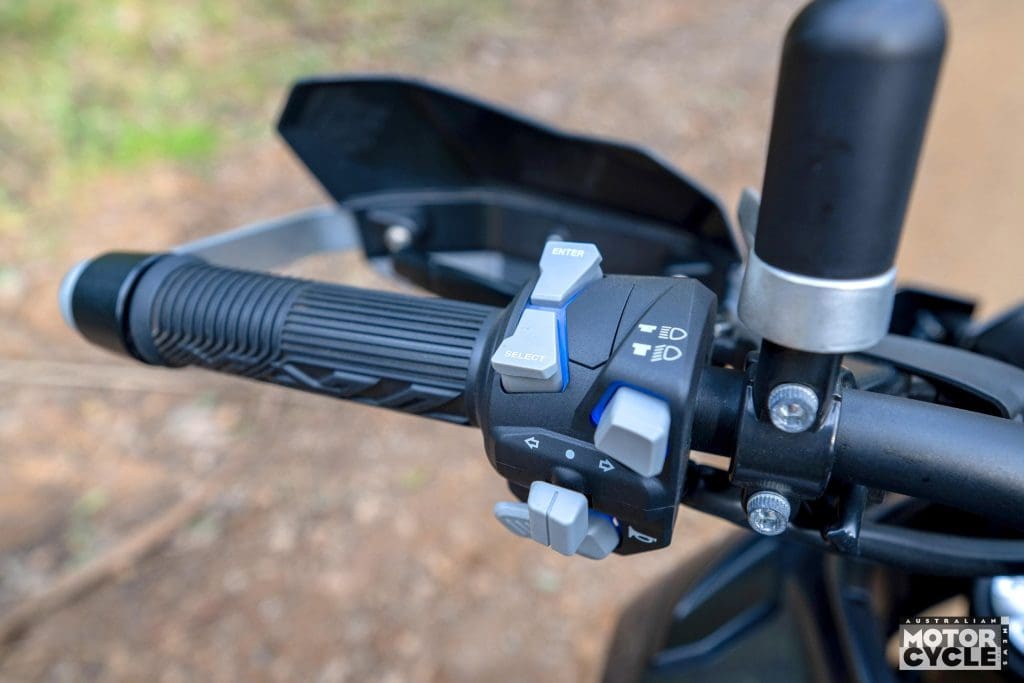
It might not be quite the right tool for motocross-style obstacles, but the TRK’s combination of dirt and sealed road prowess grants it with an astonishing bandwidth of abilities, especially when you factor in the price. Whether you’re commuting, carrying a passenger, carving around
back roads or attacking bush tracks the TRK can take on just about any role you throw at it.
If you love motorcycling and the outdoors, being able to ‘go bush’ on the same machine you ride to work on is such a fun and challenging way to test your skills that you’re really doing yourself a disservice if you don’t give the TRK a go. In a perfect world it would be nice to have traction control and a quickshifter but, given the affability and the quality of the rest of the machine, it’s not a deal-breaker.
Consider this: with the money you’re not spending on the asking price you could option the TRK up with hard luggage and crash bars, and an oversized screen is available as well. What the TRK lacks in tricks it makes up for with really solid fundamentals, and it has a rorty Italian character that charms you from the moment you throw a leg over it.
PROS: Characterful engine, wickedly versatile and fantastic bang for buck.
CONS: A quickshifter and traction control as standard fitment would be nice.

A brief history of Benelli

Benelli was established in Pesaro, Italy, in 1911 when, after the death of her husband, Teresa Boni Benelli invested all her capital into the family motorcycle repair garage in the hope of providing work for her six sons.
Two sons, Giuseppe and Giovanni, were sent to study engineering in Switzerland and, after a period manufacturing spare parts and repairing vehicles during World War I, Benelli produced its first in-house designed motorcycle in 1920. This was a 75cc two-stroke single adapted to a bicycle frame.
In 1927 Guiseppe developed a sophisticated 175cc four stroke with an overhead camshaft, which the youngest of the sons, Antonio ‘Tonino’, raced to multiple Italian road-racing titles in 1927, 1928, 1930 and 1931, further enhancing Benelli’s reputation for production and development excellence.
During World War II much of the business was destroyed or scavenged to support the conflict but, after shaky years in the late 1940s, Giovanni led the development of the 98cc two-stroke Letizia and 125cc Leoncino, with around 45,000 units sold of the latter between 1950 and 1960.
New competition from modern Japanese rivals would spell trouble for Benelli in the 70s. Even after copying Honda’s CB500 Four with the Quattro 500, decades of struggle followed. Despite building the world’s first six-cylinder motorcycle in the form of the Sei 750, a chronic lack of investment meant Benelli would later merge with rival Moto Guzzi under the management of Alejandro de Tomaso.
After a failed attempt at a rebirth in 1989, Andrea Merloni relaunched the Benelli brand in 1995. In 1999 the 900cc Tornado Tre three-cylinder sportsbike was introduced with an innovative underseat radiator cooling fan. It competed with limited success in the Superbike World Championship in the hands of Aussie Peter Goddard. An 1130cc version was also created, which spawned the naked 1130 TNT nakedbike in 2004.
In 2005, Benelli was acquired by Qianjiang Motor Group, a Chinese company which has been controlled by the Geely Holding Group since 2015. Increased stability and investment have lead to the introduction of many new Benelli models, including the popular TNT, TRK and Leoncino series.
Development and production are now split between Benelli’s traditional Italian base and its Chinese manufacturing facilities.
specifications

ENGINE
Capacity 698cc
Type Parallel-twin, DOHC, four valves per cylinder
Bore & stroke 83mm x 64.5mm
Compression ratio 11.6:1
Cooling Liquid
Fueling EFI, 41mm throttle body
Transmission Six-speed
Clutch Wet, multi-plate, slipper
Final drive Chain
PERFORMANCE
Power 51.5kW (69hp) @ 8000rpm (claimed)
Torque 70Nm @ 6000rpm (claimed)
Top speed 200km/h (claimed)
Fuel consumption 5.9L/100km (measured)
ELECTRONICS
Type Bosch
Rider aids ABS
Rider modes Not applicable
CHASSIS
Frame material Steel
Frame type Perimeter
Rake 23.8°
Trail 82.3mm
Wheelbase 1505mm
SUSPENSION
Type Showa
Front: 50mm upside-down fork, non-adjustable, 140mm travel
Rear: Monoshock, preload, compression and rebound adjustable, 173mm travel
WHEELS & BRAKES
Wheels Wire-spoked aluminium
Front: 19 x 3.0
Rear: 17 x 4.5
Tyres Pirelli Scorpian Rally STR
Front: 110/80R19
Rear: 150/70R17
Brakes ABS
Front: Twin 320mm discs, four-piston calipers
Rear: Single 260mm disc, single-piston caliper
DIMENSIONS
Weight 218kg (dry, claimed)
Seat height 835mm
Width Not given
Height 1420mm
Length Not given
Ground clearance Not given
Fuel capacity 20L
SERVICING & WARRANTY
Servicing
First: 1000km
Minor: 13,000km
Major: 25,000km
Warranty Two years, unlimited km, two years roadside assist
BUSINESS END
Price $13,590 (ride away)
Colour options Forest green, Moon grey or Anthracite grey
CONTACT
benelli.com.au
